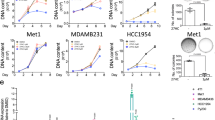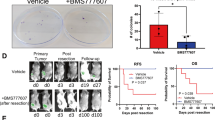Abstract
Dyslipidemia has been associated with an increased risk for developing cancer. However, the implicated mechanisms are largely unknown. To explore the role of dyslipidemia in breast cancer growth and metastasis, we used the apolipoprotein E (ApoE) knockout mice (ApoE−/−), which exhibit marked dyslipidemia, with elevated circulating cholesterol and triglyceride levels in the setting of normal glucose homeostasis and insulin sensitivity. Non-metastatic Met-1 and metastatic Mvt-1 mammary cancer cells derived from MMTV-PyVmT/FVB-N transgenic mice and c-Myc/vegf tumor explants respectively, were injected into the mammary fat pad of ApoE−/− and wild-type (WT) females consuming a high-fat/high-cholesterol diet and tumor growth was evaluated. ApoE−/− mice exhibited increased tumor growth and displayed a greater number of spontaneous metastases to the lungs. Furthermore, intravenous injection of Mvt-1 cells resulted in a greater number of pulmonary metastases in the lungs of ApoE−/− mice compared with WT controls. To unravel the molecular mechanism involved in enhanced tumor growth in ApoE−/− mice, we studied the response of Mvt-1 cells to cholesterol in vitro. We found that cholesterol increased AktS473 phosphorylation in Mvt-1 cells as well as cellular proliferation, whereas cholesterol depletion in the cell membrane abrogated AktS473 phosphorylation induced by exogenously added cholesterol. Furthermore, in vivo administration of BKM120, a small-molecule inhibitor of phosphatidylinositol 3-kinase (PI3K), alleviated dyslipidemia-induced tumor growth and metastasis in Mvt-1 model with a concomitant decrease in PI3K/Akt signaling. Collectively, we suggest that the hypercholesterolemic milieu in the ApoE−/− mice is a favorable setting for mammary tumor growth and metastasis.
This is a preview of subscription content, access via your institution
Access options
Subscribe to this journal
Receive 50 print issues and online access
$259.00 per year
only $5.18 per issue
Buy this article
- Purchase on Springer Link
- Instant access to full article PDF
Prices may be subject to local taxes which are calculated during checkout





Similar content being viewed by others
References
Bianchini F, Kaaks R, Vainio H . Overweight, obesity, and cancer risk. Lancet Oncol 2002; 3: 565–574.
Xue F, Michels KB . Diabetes, metabolic syndrome, and breast cancer: a review of the current evidence. Am J Clin Nutr 2007; 86: s823–s835.
Barone BB, Yeh HC, Snyder CF, Peairs KS, Stein KB, Derr RL et al. Long-term all-cause mortality in cancer patients with preexisting diabetes mellitus: a systematic review and meta-analysis. JAMA 2008; 300: 2754–2764.
Gallagher EJ, LeRoith D . Insulin, insulin resistance, obesity, and cancer. Curr Diab Rep 2010; 10: 93–100.
Gallagher EJ, Leroith D . Minireview: IGF, insulin, and cancer. Endocrinology 2011; 152: 2546–2551.
Novosyadlyy R, Lann DE, Vijayakumar A, Rowzee A, Lazzarino DA, Fierz Y et al. Insulin-mediated acceleration of breast cancer development and progression in a nonobese model of type 2 diabetes. Cancer Res 2010; 70: 741–751.
Fierz Y, Novosyadlyy R, Vijayakumar A, Yakar S, LeRoith D . Insulin-sensitizing therapy attenuates type 2 diabetes-mediated mammary tumor progression. Diabetes 2010; 59: 686–693.
De Stefani E, Mendilaharsu M, Deneo-Pellegrini H, Ronco A . Influence of dietary levels of fat, cholesterol, and calcium on colorectal cancer. Nutr Cancer 1997; 29: 83–89.
Platz EA, Clinton SK, Giovannucci E . Association between plasma cholesterol and prostate cancer in the PSA era. Int J Cancer 2008; 123: 1693–1698.
Zielinski CC, Stuller I, Rausch P, Muller C . Increased serum concentrations of cholesterol and triglycerides in the progression of breast cancer. J Cancer Res Clin Oncol 1988; 114: 514–518.
Chae YK, Valsecchi ME, Kim J, Bianchi AL, Khemasuwan D, Desai A et al. Reduced risk of breast cancer recurrence in patients using ACE inhibitors, ARBs, and/or statins. Cancer Invest 2011; 29: 585–593.
Edidin M . Lipids on the frontier: a century of cell-membrane bilayers. Nat Rev Mol Cell Biol 2003; 4: 414–418.
Patra SK . Dissecting lipid raft facilitated cell signaling pathways in cancer. Biochim Biophys Acta 2008; 1785: 182–206.
Li YC, Park MJ, Ye SK, Kim CW, Kim YN . Elevated levels of cholesterol-rich lipid rafts in cancer cells are correlated with apoptosis sensitivity induced by cholesterol-depleting agents. Am J Pathol 2006; 168: 1107–1118; quiz 404-5.
Freeman MR, Solomon KR . Cholesterol and prostate cancer. J Cell Biochem 2004; 91: 54–69.
Graziani SR, Igreja FA, Hegg R, Meneghetti C, Brandizzi LI, Barboza R et al. Uptake of a cholesterol-rich emulsion by breast cancer. Gynecol Oncol 2002; 85: 493–497.
Freeman MR, Di Vizio D, Solomon KR . The Rafts of the Medusa: cholesterol targeting in cancer therapy. Oncogene 2010; 29: 3745–3747.
Zhuang L, Kim J, Adam RM, Solomon KR, Freeman MR . Cholesterol targeting alters lipid raft composition and cell survival in prostate cancer cells and xenografts. J Clin Invest 2005; 115: 959–968.
Zhuang L, Lin J, Lu ML, Solomon KR, Freeman MR . Cholesterol-rich lipid rafts mediate akt-regulated survival in prostate cancer cells. Cancer Res 2002; 62: 2227–2231.
Adam RM, Mukhopadhyay NK, Kim J, Di Vizio D, Cinar B, Boucher K et al. Cholesterol sensitivity of endogenous and myristoylated Akt. Cancer Res 2007; 67: 6238–6246.
Demierre MF, Higgins PD, Gruber SB, Hawk E, Lippman SM . Statins and cancer prevention. Nat Rev Cancer 2005; 5: 930–942.
Platz EA, Leitzmann MF, Visvanathan K, Rimm EB, Stampfer MJ, Willett WC et al. Statin drugs and risk of advanced prostate cancer. J Natl Cancer Inst 2006; 98: 1819–1825.
Mondul AM, Caffo B, Platz EA . Minimal detection bias in the inverse association between statin drug use and advanced prostate cancer risk: a simulation study. Cancer Epidemiol 2011; 35: e6–11.
Giovannucci E, Liu Y, Platz EA, Stampfer MJ, Willett WC . Risk factors for prostate cancer incidence and progression in the health professionals follow-up study. Int J Cancer 2007; 121: 1571–1578.
Cauley JA, Zmuda JM, Lui LY, Hillier TA, Ness RB, Stone KL et al. Lipid-lowering drug use and breast cancer in older women: a prospective study. J Womens Health (Larchmt) 2003; 12: 749–756.
Kawashima Y, Chen J, Sun H, Lann D, Hajjar RJ, Yakar S et al. Apolipoprotein E deficiency abrogates insulin resistance in a mouse model of type 2 diabetes mellitus. Diabetologia 2009; 52: 1434–1441.
Zhang SH, Reddick RL, Piedrahita JA, Maeda N . Spontaneous hypercholesterolemia and arterial lesions in mice lacking apolipoprotein E. Science 1992; 258: 468–471.
Alexopoulos CG, Blatsios B, Avgerinos A . Serum lipids and lipoprotein disorders in cancer patients. Cancer 1987; 60: 3065–3070.
Favrot MC, Dellamonica C, Souillet G . Study of blood lipids in 30 children with a malignant hematological disease or carcinoma. Biomed Pharmacother 1984; 38: 55–59.
Halton JM, Nazir DJ, McQueen MJ, Barr RD . Blood lipid profiles in children with acute lymphoblastic leukemia. Cancer 1998; 83: 379–384.
Sekine Y, Koike H, Nakano T, Nakajima K, Takahashi S, Suzuki K . Remnant lipoproteins induced proliferation of human prostate cancer cell, PC-3 but not LNCaP, via low density lipoprotein receptor. Cancer Epidemiol 2009; 33: 16–23.
Mandal CC, Ghosh-Choudhury N, Yoneda T, Choudhury GG . Simvastatin prevents skeletal metastasis of breast cancer by an antagonistic interplay between p53 and CD44. J Biol Chem 2011; 286: 11314–11327.
Hu J, La Vecchia C, de Groh M, Negri E, Morrison H, Mery L . Dietary cholesterol intake and cancer. Ann Oncol 2012; 23: 491–500.
Fidler IJ . The pathogenesis of cancer metastasis: the ‘seed and soil’ hypothesis revisited. Nat Rev Cancer 2003; 3: 453–458.
Minn AJ, Gupta GP, Padua D, Bos P, Nguyen DX, Nuyten D et al. Lung metastasis genes couple breast tumor size and metastatic spread. Proc Natl Acad Sci USA 2007; 104: 6740–6745.
Caldieri G, Buccione R . Aiming for invadopodia: organizing polarized delivery at sites of invasion. Trends Cell Biol 2010; 20: 64–70.
Cully M, You H, Levine AJ, Mak TW . Beyond PTEN mutations: the PI3K pathway as an integrator of multiple inputs during tumorigenesis. Nat Rev Cancer 2006; 6: 184–192.
Dansky HM, Charlton SA, Sikes JL, Heath SC, Simantov R, Levin LF et al. Genetic background determines the extent of atherosclerosis in ApoE-deficient mice. Arterioscler Thromb Vasc Biol 1999; 19: 1960–1968.
Borowsky AD, Namba R, Young LJ, Hunter KW, Hodgson JG, Tepper CG et al. Syngeneic mouse mammary carcinoma cell lines: two closely related cell lines with divergent metastatic behavior. Clin Exp Metastasis 2005; 22: 47–59.
Pei XF, Noble MS, Davoli MA, Rosfjord E, Tilli MT, Furth PA et al. Explant-cell culture of primary mammary tumors from MMTV-c-Myc transgenic mice. In Vitro Cell Dev Biol Anim 2004; 40: 14–21.
Acknowledgements
This work was supported by ADA mentor-based postdoctoral fellowship award 7-08-MN-33 and National Cancer Institute Grant RO1CA128799, both to DLR. We thank Novartis for providing us with BKM120 compound. In addition, partial support was from the Israel Cancer Association to DLR.
Author information
Authors and Affiliations
Corresponding author
Ethics declarations
Competing interests
The authors declare no conflict of interest.
Rights and permissions
About this article
Cite this article
Alikhani, N., Ferguson, R., Novosyadlyy, R. et al. Mammary tumor growth and pulmonary metastasis are enhanced in a hyperlipidemic mouse model. Oncogene 32, 961–967 (2013). https://doi.org/10.1038/onc.2012.113
Received:
Revised:
Accepted:
Published:
Issue Date:
DOI: https://doi.org/10.1038/onc.2012.113
Keywords
This article is cited by
-
NUCB2/Nesfatin-1 drives breast cancer metastasis through the up-regulation of cholesterol synthesis via the mTORC1 pathway
Journal of Translational Medicine (2023)
-
A pan-cancer analysis of the oncogenic and immunological roles of apolipoprotein F (APOF) in human cancer
European Journal of Medical Research (2023)
-
Annexin A6 and NPC1 regulate LDL-inducible cell migration and distribution of focal adhesions
Scientific Reports (2022)
-
Cholesterol homeostasis and cancer: a new perspective on the low-density lipoprotein receptor
Cellular Oncology (2022)
-
Mild dyslipidemia accelerates tumorigenesis through expansion of Ly6Chi monocytes and differentiation to pro-angiogenic myeloid cells
Nature Communications (2022)



